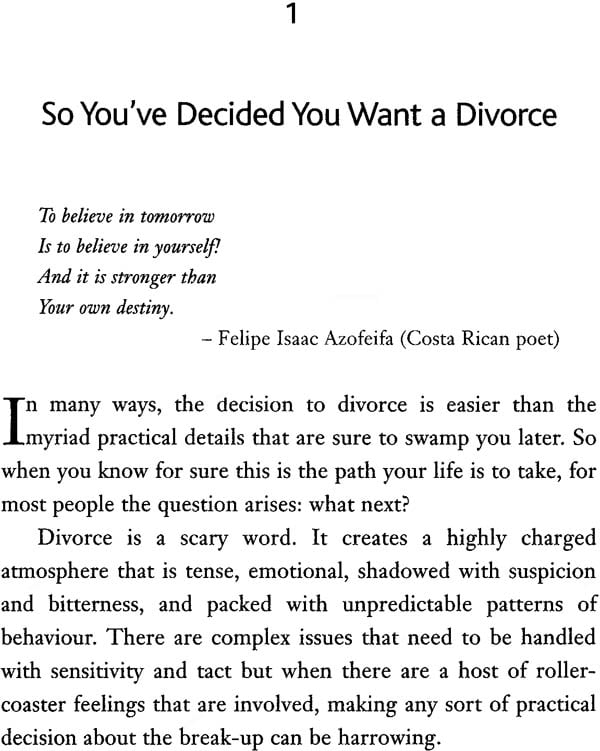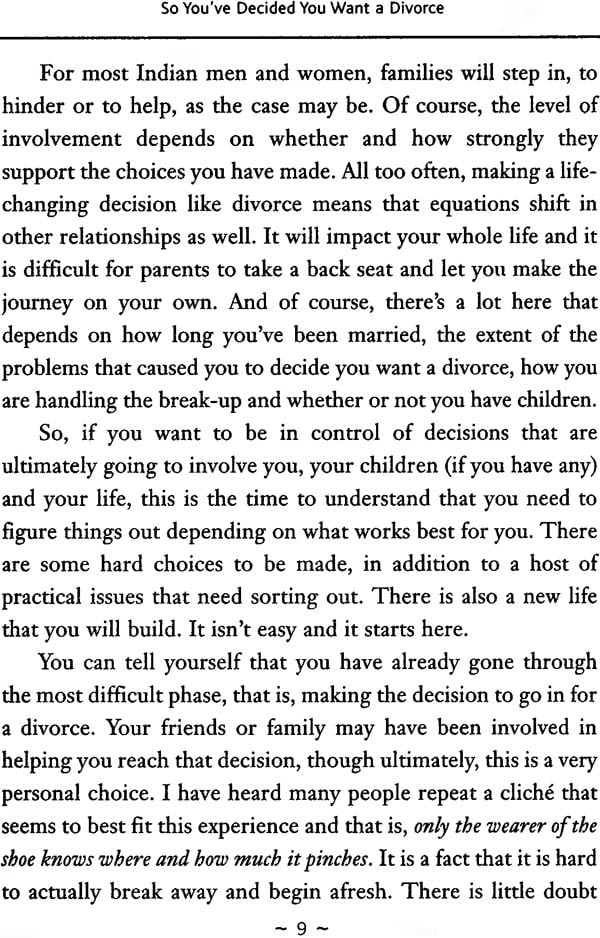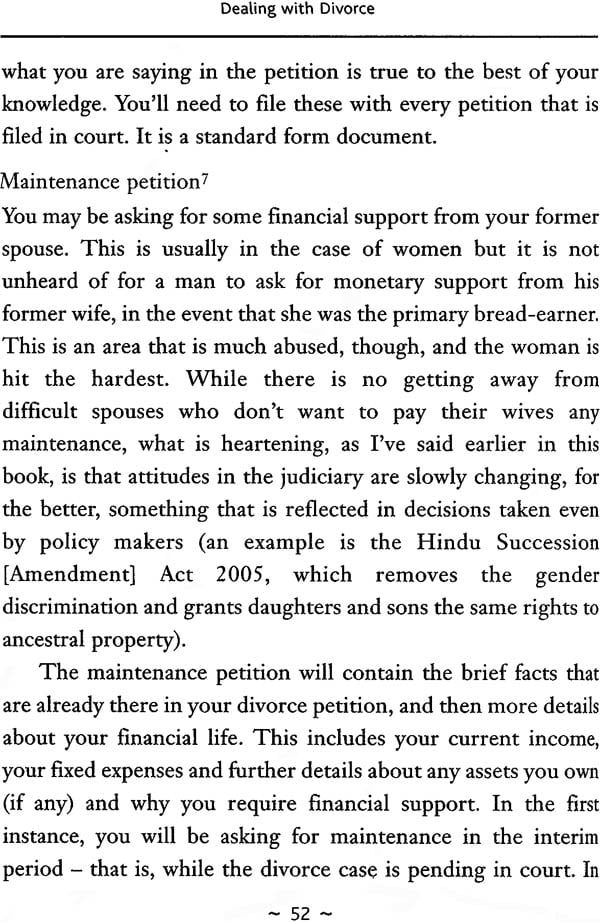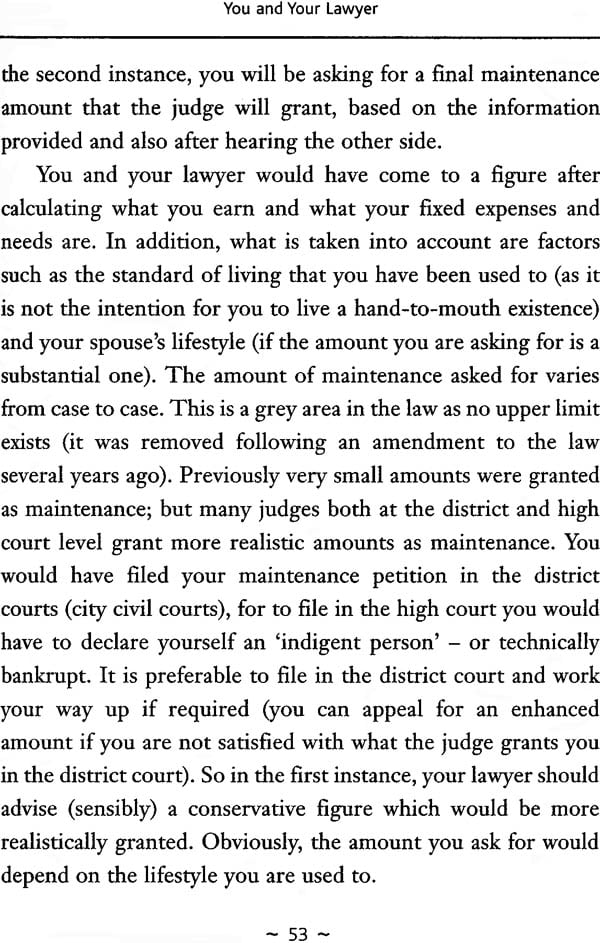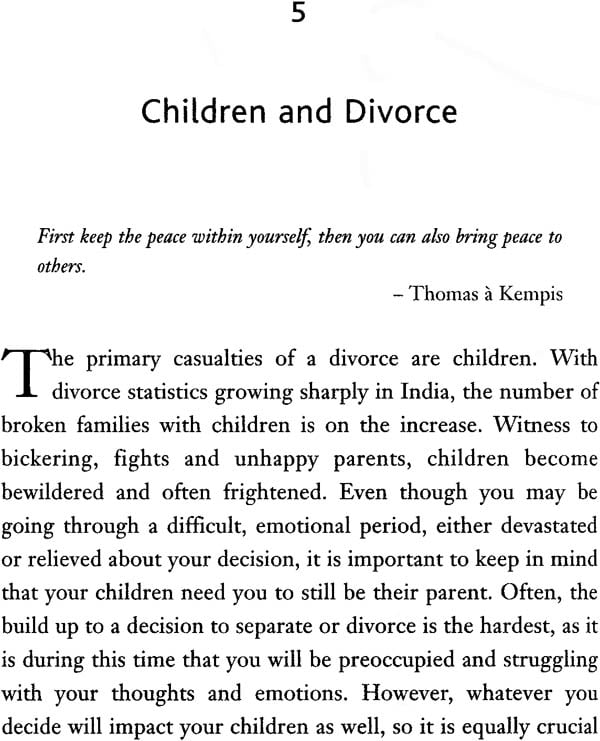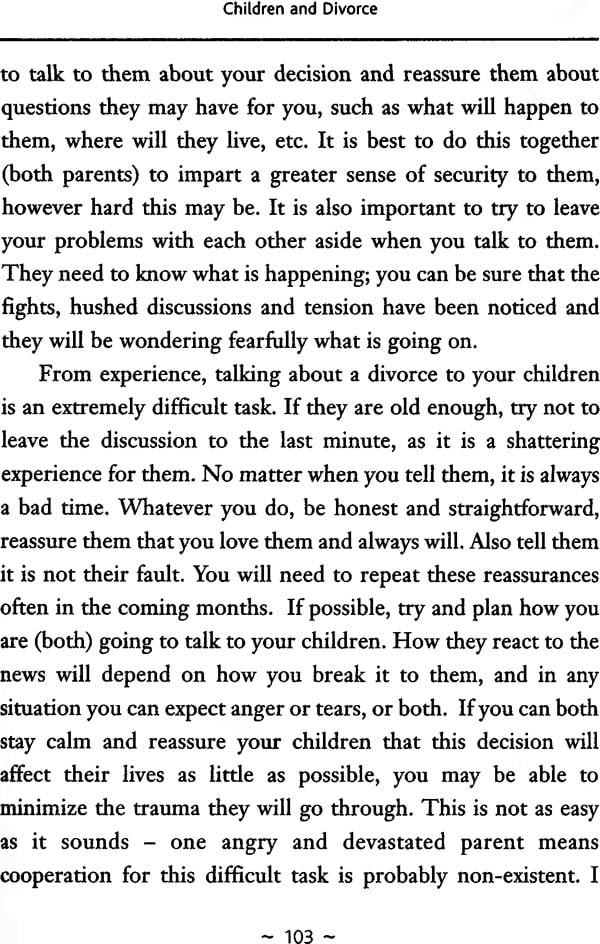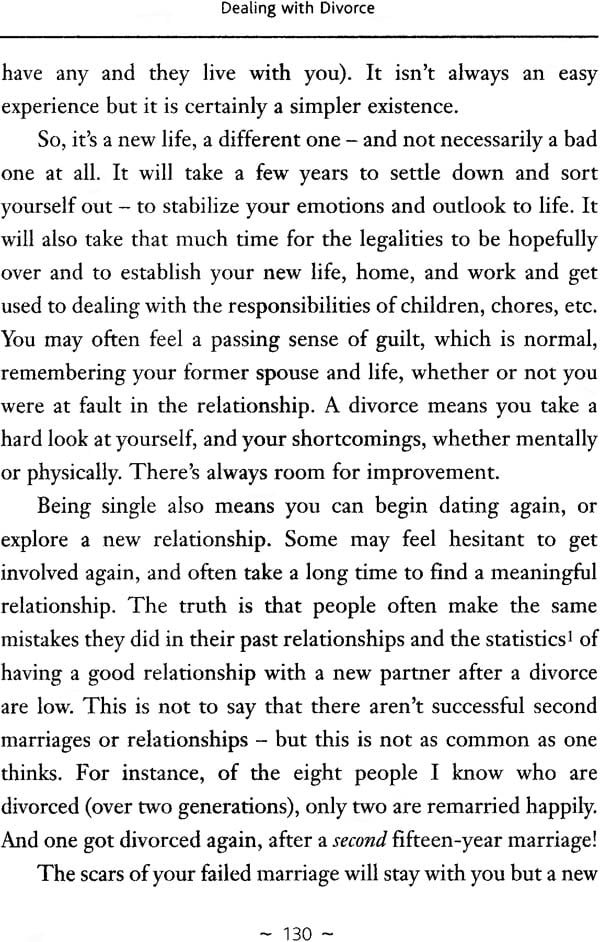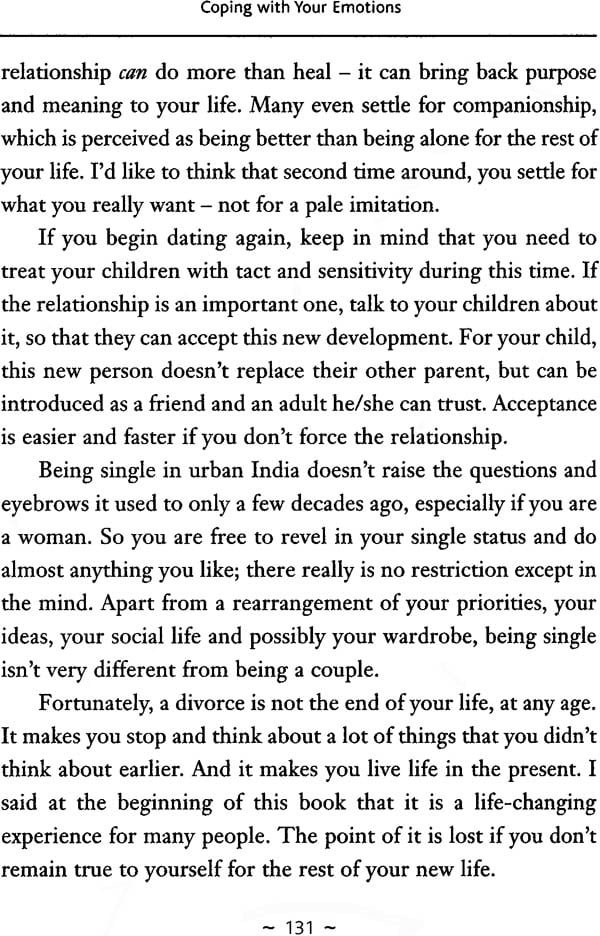
Dealing with Divorce (The Essential Handbook)
Book Specification
| Item Code: | NAF732 |
| Author: | Leela Kirloskar |
| Publisher: | Lotus Collection and Roli Books |
| Language: | English |
| Edition: | 2007 |
| ISBN: | 9788174365118 |
| Pages: | 138 |
| Cover: | Paperback |
| Other Details | 7.00 inch x 5.00 inc |
| Weight | 130 gm |
Book Description
Dealing with Divorce is a compassionate and authoritative handbook, a first of its kind in India,that helps you through the overwhelming experience of divorce. Updated with changes in divorce laws and norms, it guides you through the legal, financial and emotional realities of the divorce process. The book helps you navigate each step after your initial decision to the final dissolution. The book will tell you about:
. Choosing a lawyer
. What law applies to you
. What to expect before and in court
. How to break the news to your children
. Law regarding the custody of children
. Dealing with emotions.
Leela Kirloskar is presently senior commissioning editor for Response, the business books imprint of SAGE Publications India Pvt Ltd. She qualifying as a lawyer in 1993 and practiced law for about five years, before moving on to a less cerebal activity- desserts from home on order through Leela’s Kitchen – for a few years. Leela switched to publishing in 2001 and worked part- time as a freelance copy editor, doing assign,ents for leading publishing houses and institutions in the areas of social science, business management, law, disaster management and the environment, among others. She is the author of four retold classic stories for early learners. Leela is a single, proud mother of two beautiful boys, Kartik (17) and Raghav (14). She enjoys baking reading, travelling and spending time with her children.
Divorce is not an easy process to go through for any individual, emotionally or practically. It is a painful, life- changing experience during which you will find your every belief challenged. While there are plenty of books and web sites to help you deal with the emotional ups and downs, you will find only legal tomes fit for a trained lawyer to understand on the more practical and material aspects f divorce in India. There is also very little practical information about how to actually go about obtaining a divorce and what you can expect during this process. It is either too limited, or too wrapped up in legalese to be of any real use.
So, most people often do not even know the next logical step to take, apart from physical separation. The confusion about the legal procedure may also be compounded because of the conflicting emotions a person goes through after ending bad marriage, and the overwhelming practical issues suddenly dumped on them. Added to this is the baggage of social stigma, which still exists to some degree and the withdrawal from society, which is partly protective and partly forced. With too much to cope with, the legal aspects do not dawn until months or even a few years, later. And then you find yourself in a quagmire floundering through complicated procedures and completely dependent upon your lawyer/s to guide you through to final freedom, barely understanding what your rights are, much less your obligations.
This book attempts to explain the process of divorce India and the legal provisions a simply as possible. India has the most complex family laws in the world. Along with the social, familial and emotional pressures you will inevitably face, it is a complicated recipe most people would not like to taste. The need for information on how to get out of bad marriage legally, becomes of paramount importance, once the decision to divorce is finally taken. Statistics reveal a steep rise in marriage in India ending in divorce courts; in fact, 70 per cent of these figures represent young people in the age group of 25-35. Amicable separation within the first year of marriage has increased by 30 per cent since 2000, while 85 per cent went in for divorce within the first five years of marriage.
According to the last census of 2001, divorce rates have gone up sharply over recent years mainly in cities, from 4 per cent in the 1980s to 14 per cent in 2001. In Mumbai alone, the percentage shot up by 56 per cent between 1991 and 2001; according to Indian Statistical institute figures, in recent years have definitely gone up. Interestingly, women make up a huge percentage of the population calling it quits in a marriage, due to mental or physical cruelty, or for other equally compelling reasons, cutting across economic and social strata, in rural and urban India. This is probably due to better education, more awareness and a greater degree of economic independence.
Due to its diversity, India has several laws under which marriages are solemnized and a divorce can be obtained. These include The Hindu Marriage Act, 1955; The Divorce Act, 1869; The Paris Marriage and Divorce Act, 1936; The Dissolution of Muslim Marriage act, 1939; The Muslin Women 9Protection of Rights on Divorce) Act, 1986; The special Marriage Act, 1956; and The Foreign Marriage Act, 1969. The basic provisions of these acts regarding how to obtain a divorce have been explained as clearly and concisely as possible. Discussions with professionals also provide the reader with a practical viewpoint of the entire procedure.
Over the years, several amendments to these acts and a few new ones, such as the recent, much lauded The Protection of Women from Domestic Violence Act,2005, have ensured the slow but steady progress and recognition of individual rights, While there is certainly scope for much more for fair and progressive divorce laws, it is encouraging to note that attitudes are changing and that judges today, in courts at all levels, are more sensitive towards gender issues and are more willing to recognize practical difficulties and address the concerns involved in each case.
In addition to a brief but thorough overview of the divorce laws in India, I have included essential practical things to remember while going through a separation and divorce, what to expect from your lawyer, coping with children during divorce and the intricacies of custody laws. Finally, I have included a chapter on understanding and coping with your own emotions and dealing with being single again.
With a supportive and loving family, going through a divorce is much easier; however, more often than not, the family structure in India is one that believes in protecting the family, not destroying it. So be prepared for a battle, both in your family and in the courts. Ultimately, if it is your well- being at risk, most families will rally around and protect their own.
As you may be aware, the law in India takes its own course, so the key word (or mantra) here is patience, Delays, adjournments and plain screw- ups are an unpleasant fact of the Indian legal system, So, until substantial improvements are made not just in the laws but in the system itself, you just need to tell yourself be patient. The best advice I received from my lawyer when I filed for divorce was to put it behind me and get on with my life. That is the only thing the law books do not tell you- that after you file for divorce, it can, unfortunately, take years to conclude this chapter in your life. Though it is far easier said than done, it is the only way to remain sane and move on.
For those of us who have experienced the grief of bad marriages, curiously, there is a lot of peace to be discovered during this time (when you are waiting for the legal formalities to be over). This book assumes the decision to divorce is final and that there is no going back. I believe that during this difficult time in your life, in order to look forward, it is always a good thing to arm yourself with courage and patience, and believe it will get better. As TUT2 puts it, “ Thoughts become things..so choose the good ones! There is a lot to be said for the power of positive thinking, and this is the time you will need it the most.
Although this book is as comprehensive as possible, it is by no means exhaustive. As mentioned earlier, it is intended only as guide for those of you who want to get out of a bad marriage. It is, so speak, a step – by step guide, to divorce and all the issues you need to cope with so that you can get your life back on track and to help you gain more control over it. I have include brief real- life experiences where relevant, and mentioned a few recent and important judgements to explain some legal concepts and keep the reader abreast of latest developments. Since it is legal precedent that matters in this field, I felt it was an important area to cover and I have tried to make it as simple as possible. I hope you find the book useful and informative. It is not meant to be a replacement for a lawyer – so please do consult with one to undertake and sort out the legalities of your divorce.
Finally, I’d like to thank all those who helped me shape this book- Renuka Chatterjee of Roli Books, for suggesting the idea and believing I could write it; Ashok Panda, Kalpana and Ravi Masur for reading and veting the legal portions; my father, Sukumar R. Kirloskar for endlessly reading drafts of the manuscript and for all his patience and encouragement (and to my mother for looking over his shoulder and cheering the books the people in this world whom I love- a very big thank you for being there for me through this very difficult boys, Kartik and Raghav, for their complete support, understanding and love. It’s been a great journey of self-discovery.
| Introduction | 1 | |
| 1 | So You've Decided you Want a Divorce | 8 |
| 2 | You and Your Lawyer | 33 |
| 3 | Divorce Under Hindu Law | 58 |
| 4 | Divorce Under Other Laws in India | 83 |
| 5 | Children and Divorce | 102 |
| 6 | Coping with Your Emotions | 120 |
| Checklist | 133 | |
| Useful Resources | 136 |
